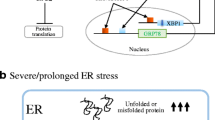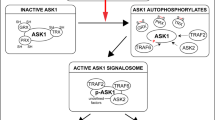Abstract
In routine course of life, nonsteroidal anti-inflammatory drugs (NSAIDs) are widely prescribed antipyretic, analgesic, and anti-inflammatory drugs. It is a well-proposed notion that treatment of NSAIDs may induce anti-proliferative effects in numerous cancer cells. Ibuprofen from isobutylphenylpropanoic acid is NSAID and used to relieve fever, pain, and inflammation. It is also used for juvenile idiopathic arthritis, rheumatoid arthritis, patent ductus arteriosus, and for pericarditis. Despite few emerging studies have expanded the fundamental concept that the treatment of NSAIDs influences apoptosis in cancer cells, however the NSAID-mediated precise mechanisms that determine apoptosis induction without producing adverse consequences in variety of cancer cells are largely unknown. In our present study, we have observed that ibuprofen reduces proteasome activity, enhances the aggregation of ubiquitylated abnormal proteins, and also elevates the accumulation of crucial proteasome substrates. Ibuprofen treatment causes mitochondrial abnormalities and releases cytochrome c into cytosol. Perhaps, the more detailed study is needed in the future to elucidate the molecular mechanisms of NSAIDs that can induce apoptosis without adverse effects and produce effective anti-tumor effects and consequently help in neurodegeneration and ageing.








Similar content being viewed by others
References
Singh R, Cadeddu RP, Frobel J, Wilk CM, Bruns I, Zerbini LF, Prenzel T, Hartwig S et al (2011) The non-steroidal anti-inflammatory drugs sulindac sulfide and diclofenac induce apoptosis and differentiation in human acute myeloid leukemia cells through an AP-1 dependent pathway. Apoptosis 16(9):889–901. doi:10.1007/s10495-011-0624-y
Adachi M, Sakamoto H, Kawamura R, Wang W, Imai K, Shinomura Y (2007) Nonsteroidal anti-inflammatory drugs and oxidative stress in cancer cells. Histol Histopathol 22(4):437–442
Tsutsumi S, Gotoh T, Tomisato W, Mima S, Hoshino T, Hwang HJ, Takenaka H, Tsuchiya T et al (2004) Endoplasmic reticulum stress response is involved in nonsteroidal anti-inflammatory drug-induced apoptosis. Cell Death Differ 11(9):1009–1016. doi:10.1038/sj.cdd.4401436
Kopp E, Ghosh S (1994) Inhibition of NF-kappa B by sodium salicylate and aspirin. Science 265(5174):956–959
Ryu YS, Lee JH, Seok JH, Hong JH, Lee YS, Lim JH, Kim YM, Hur GM (2000) Acetaminophen inhibits iNOS gene expression in RAW 264.7 macrophages: differential regulation of NF-kappaB by acetaminophen and salicylates. Biochem Biophys Res Commun 272(3):758–764. doi:10.1006/bbrc.2000.2863
Watanabe T, Tanigawa T, Nadatani Y, Otani K, Machida H, Okazaki H, Yamagami H, Watanabe K et al (2011) Mitochondrial disorders in NSAIDs-induced small bowel injury. J Clin Biochem Nutr 48(2):117–121. doi:10.3164/jcbn.10-73
Somasundaram S, Rafi S, Hayllar J, Sigthorsson G, Jacob M, Price AB, Macpherson A, Mahmod T et al (1997) Mitochondrial damage: a possible mechanism of the “topical” phase of NSAID induced injury to the rat intestine. Gut 41(3):344–353
Huang YC, Chuang LY, Hung WC (2002) Mechanisms underlying nonsteroidal anti-inflammatory drug-induced p27(Kip1) expression. Mol Pharmacol 62(6):1515–1521
Dikshit P, Chatterjee M, Goswami A, Mishra A, Jana NR (2006) Aspirin induces apoptosis through the inhibition of proteasome function. J Biol Chem 281(39):29228–29235. doi:10.1074/jbc.M602629200
Berns M, Toennessen M, Koehne P, Altmann R, Obladen M (2009) Ibuprofen augments bilirubin toxicity in rat cortical neuronal culture. Pediatr Res 65(4):392–396. doi:10.1203/PDR.0b013e3181991511
Ikegaki N, Hicks SL, Regan PL, Jacobs J, Jumbo AS, Leonhardt P, Rappaport EF, Tang XX (2013) S(+)-ibuprofen destabilizes MYC/MYCN and AKT, increases p53 expression, and induces unfolded protein response and favorable phenotype in neuroblastoma cell lines. Int J Oncol 44(1):35–43. doi:10.3892/ijo.2013.2148
Al-Nasser IA (2000) Ibuprofen-induced liver mitochondrial permeability transition. Toxicol Lett 111(3):213–218
Moorthy M, Fakurazi S, Ithnin H (2008) Morphological alteration in mitochondria following diclofenac and ibuprofen administration. Pak J Biol Sci 11(15):1901–1908
Gomez-Olivan LM, Galar-Martinez M, Garcia-Medina S, Valdes-Alanis A, Islas-Flores H, Neri-Cruz N (2014) Genotoxic response and oxidative stress induced by diclofenac, ibuprofen and naproxen in Daphnia magna. Drug Chem Toxicol 37(4):391–399. doi:10.3109/01480545.2013.870191
Yin MJ, Yamamoto Y, Gaynor RB (1998) The anti-inflammatory agents aspirin and salicylate inhibit the activity of I(kappa)B kinase-beta. Nature 396(6706):77–80. doi:10.1038/23948
Pierce JW, Read MA, Ding H, Luscinskas FW, Collins T (1996) Salicylates inhibit I kappa B-alpha phosphorylation, endothelial-leukocyte adhesion molecule expression, and neutrophil transmigration. J Immunol 156(10):3961–3969
Scheuren N, Bang H, Munster T, Brune K, Pahl A (1998) Modulation of transcription factor NF-kappaB by enantiomers of the nonsteroidal drug ibuprofen. Br J Pharmacol 123(4):645–652. doi:10.1038/sj.bjp.0701652
Qiu JH, Asai A, Chi S, Saito N, Hamada H, Kirino T (2000) Proteasome inhibitors induce cytochrome c-caspase-3-like protease-mediated apoptosis in cultured cortical neurons. J Neurosci Off J Soc Neurosci 20(1):259–265
Goldbaum O, Vollmer G, Richter-Landsberg C (2006) Proteasome inhibition by MG-132 induces apoptotic cell death and mitochondrial dysfunction in cultured rat brain oligodendrocytes but not in astrocytes. Glia 53(8):891–901. doi:10.1002/glia.20348
Chauhan D, Catley L, Li G, Podar K, Hideshima T, Velankar M, Mitsiades C, Mitsiades N et al (2005) A novel orally active proteasome inhibitor induces apoptosis in multiple myeloma cells with mechanisms distinct from Bortezomib. Cancer Cell 8(5):407–419. doi:10.1016/j.ccr.2005.10.013
Riley TR 3rd, Smith JP (1998) Ibuprofen-induced hepatotoxicity in patients with chronic hepatitis C: a case series. Am J Gastroenterol 93(9):1563–1565. doi:10.1111/j.1572-0241.1998.00484.x
O’Connor N, Dargan PI, Jones AL (2003) Hepatocellular damage from non-steroidal anti-inflammatory drugs. QJM 96(11):787–791
Chhangani D, Mishra A (2013) Protein quality control system in neurodegeneration: a healing company hard to beat but failure is fatal. Mol Neurobiol 48(1):141–156. doi:10.1007/s12035-013-8411-0
Palayoor ST, Youmell MY, Calderwood SK, Coleman CN, Price BD (1999) Constitutive activation of IkappaB kinase alpha and NF-kappaB in prostate cancer cells is inhibited by ibuprofen. Oncogene 18(51):7389–7394. doi:10.1038/sj.onc.1203160
Hung WC, Chang HC, Pan MR, Lee TH, Chuang LY (2000) Induction of p27(KIP1) as a mechanism underlying NS398-induced growth inhibition in human lung cancer cells. Mol Pharmacol 58(6):1398–1403
Dey A, Tergaonkar V, Lane DP (2008) Double-edged swords as cancer therapeutics: simultaneously targeting p53 and NF-kappaB pathways. Nat Rev Drug Discov 7(12):1031–1040. doi:10.1038/nrd2759
Pyrko P, Kardosh A, Liu YT, Soriano N, Xiong W, Chow RH, Uddin J, Petasis NA et al (2007) Calcium-activated endoplasmic reticulum stress as a major component of tumor cell death induced by 2,5-dimethyl-celecoxib, a non-coxib analogue of celecoxib. Mol Cancer Ther 6(4):1262–1275. doi:10.1158/1535-7163.MCT-06-0629
Lal N, Kumar J, Erdahl WE, Pfeiffer DR, Gadd ME, Graff G, Yanni JM (2009) Differential effects of non-steroidal anti-inflammatory drugs on mitochondrial dysfunction during oxidative stress. Arch Biochem Biophys 490(1):1–8
Pique M, Barragan M, Dalmau M, Bellosillo B, Pons G, Gil J (2000) Aspirin induces apoptosis through mitochondrial cytochrome c release. FEBS Lett 480(2-3):193–196
Zimmermann KC, Waterhouse NJ, Goldstein JC, Schuler M, Green DR (2000) Aspirin induces apoptosis through release of cytochrome c from mitochondria. Neoplasia 2(6):505–513
Galati G, Tafazoli S, Sabzevari O, Chan TS, O’Brien PJ (2002) Idiosyncratic NSAID drug induced oxidative stress. Chem Biol Interact 142(1–2):25–41
Jana NR (2008) NSAIDs and apoptosis. Cell Mol Life Sci 65(9):1295–1301. doi:10.1007/s00018-008-7511-x
Tsutsumi S, Namba T, Tanaka KI, Arai Y, Ishihara T, Aburaya M, Mima S, Hoshino T et al (2006) Celecoxib upregulates endoplasmic reticulum chaperones that inhibit celecoxib-induced apoptosis in human gastric cells. Oncogene 25(7):1018–1029. doi:10.1038/sj.onc.1209139
Grilli M, Pizzi M, Memo M, Spano P (1996) Neuroprotection by aspirin and sodium salicylate through blockade of NF-kappaB activation. Science 274(5291):1383–1385
Kazmi SM, Plante RK, Visconti V, Taylor GR, Zhou L, Lau CY (1995) Suppression of NF kappa B activation and NF kappa B-dependent gene expression by tepoxalin, a dual inhibitor of cyclooxygenase and 5-lipoxygenase. J Cell Biochem 57(2):299–310. doi:10.1002/jcb.240570214
Brooks G, Yu XM, Wang Y, Crabbe MJ, Shattock MJ, Harper JV (2003) Non-steroidal anti-inflammatory drugs (NSAIDs) inhibit vascular smooth muscle cell proliferation via differential effects on the cell cycle. J Pharm Pharmacol 55(4):519–526. doi:10.1211/002235702775
Zhou XM, Wong BC, Fan XM, Zhang HB, Lin MC, Kung HF, Fan DM, Lam SK (2001) Non-steroidal anti-inflammatory drugs induce apoptosis in gastric cancer cells through up-regulation of bax and bak. Carcinogenesis 22(9):1393–1397
Marra DE, Simoncini T, Liao JK (2000) Inhibition of vascular smooth muscle cell proliferation by sodium salicylate mediated by upregulation of p21(Waf1) and p27(Kip1). Circulation 102(17):2124–2130
Bock JM, Menon SG, Goswami PC, Sinclair LL, Bedford NS, Domann FE, Trask DK (2007) Relative non-steroidal anti-inflammatory drug (NSAID) antiproliferative activity is mediated through p21-induced G1 arrest and E2F inhibition. Mol Carcinog 46(10):857–864. doi:10.1002/mc.20318
Endo H, Yano M, Okumura Y, Kido H (2014) Ibuprofen enhances the anticancer activity of cisplatin in lung cancer cells by inhibiting the heat shock protein 70. Cell Death Dis 5, e1027. doi:10.1038/cddis.2013.550
Zhang X, Fryknas M, Hernlund E, Fayad W, De Milito A, Olofsson MH, Gogvadze V, Dang L et al (2014) Induction of mitochondrial dysfunction as a strategy for targeting tumour cells in metabolically compromised microenvironments. Nat Commun 5:3295. doi:10.1038/ncomms4295
Naito Y, Yoshikawa T (2006) Oxidative stress involvement and gene expression in indomethacin-induced gastropathy. Redox Rep 11(6):243–253. doi:10.1179/135100006X155021
Nagano Y, Matsui H, Tamura M, Shimokawa O, Nakamura Y, Kaneko T, Hyodo I (2012) NSAIDs and acidic environment induce gastric mucosal cellular mitochondrial dysfunction. Digestion 85(2):131–135. doi:10.1159/000334685
Riemer C, Burwinkel M, Schwarz A, Gultner S, Mok SW, Heise I, Holtkamp N, Baier M (2008) Evaluation of drugs for treatment of prion infections of the central nervous system. J Gen Virol 89(Pt 2):594–597. doi:10.1099/vir.0.83281-0
Chhangani D, Upadhyay A, Amanullah A, Joshi V, Mishra A (2014) Ubiquitin ligase ITCH recruitment suppresses the aggregation and cellular toxicity of cytoplasmic misfolded proteins. Sci Rep 4:5077. doi:10.1038/srep05077
Chhangani D, Nukina N, Kurosawa M, Amanullah A, Joshi V, Upadhyay A, Mishra A (2014) Mahogunin ring finger 1 suppresses misfolded polyglutamine aggregation and cytotoxicity. Biochim Biophys Acta 1842(9):1472–1484. doi:10.1016/j.bbadis.2014.04.014
Grosdidier A, Zoete V, Michielin O (2011) SwissDock, a protein-small molecule docking web service based on EADock DSS. Nucleic Acids Res 39(Web Server issue):W270–W277. doi:10.1093/nar/gkr366
Pettersen EF, Goddard TD, Huang CC, Couch GS, Greenblatt DM, Meng EC, Ferrin TE (2004) UCSF Chimera—a visualization system for exploratory research and analysis. J Comput Chem 25(13):1605–1612. doi:10.1002/jcc.20084
Irwin JJ, Shoichet BK (2005) ZINC—a free database of commercially available compounds for virtual screening. J Chem Inf Model 45(1):177–182. doi:10.1021/ci049714+
Groll M, Koguchi Y, Huber R, Kohno J (2001) Crystal structure of the 20 S proteasome:TMC-95A complex: a non-covalent proteasome inhibitor. J Mol Biol 311(3):543–548. doi:10.1006/jmbi.2001.4869
Chhangani D, Mishra A (2013) Mahogunin ring finger-1 (MGRN1) suppresses chaperone-associated misfolded protein aggregation and toxicity. Sci Rep 3:1972. doi:10.1038/srep01972
Acknowledgments
This work was supported by the Department of Biotechnology, Government of India. AM was supported by Ramalinganswami Fellowship (BT/RLF/Reentry/11/2010) and Innovative Young Biotechnologist Award (IYBA) scheme (BT/06/IYBA/2012) from the Department of Biotechnology, Government of India. AU and VJ were supported by research fellowship from University Grants Commission, Council of Scientific and Industrial Research, Government of India. The authors would like to thank Mr. Bharat Pareek for his technical assistance and entire lab management during the manuscript preparation. We would also thank all for gifted plasmids: Dr. Nihar Ranjan Jana (National Brain Research Centre, Manesar, Gurgaon, India) for pd1EGFP plasmid, Dr. I. M. Verma (Salk Institute for Biological Studies, La Jolla, CA, USA) for pCMX-IκBα plasmid, Dr. Aleem Siddiqui (UC San Diego, Gilman Dr. La Jolla, CA) for p3x-κB-Luc plasmid, Dr. Lois Greene (Laboratory of Cell Biology, NHLBI, NIH, Bethesda, MD) for the pEGFP hsp70 construct, Dr. Ted Dawson (Johns Hopkins University Institute for Cell Engineering, North Broadway St. Baltimore, MD, USA) for pRK5-HA-Ubiquitin-WT plasmid, Dr. Csaba Soti (Department of Medical Chemistry, Semmelweis University, Budapest, Hungary) for GFP-wtCAT plasmid, Dr. Ron R. Kopito (Stanford University Biology Department Lorry Lokey Bldg Campus Drive Stanford CA) for pEGFP-C1 CFTRΔF508 plasmid, Dr. Nico Dantuma (Karolinska Institutet, Department of Cell and Molecular Biology, Stockholm, Sweden) for the GFP-Ubiquitin plasmid, and Dr. A Tunnacliffe (Department of Chemical Engineering and Biotechnology, University of Cambridge, Cambridge, UK) for EGFP-HDQ23 and EGFP-HDQ74 constructs.
Author information
Authors and Affiliations
Corresponding author
Ethics declarations
Conflict of Interest
The authors do not have any actual or potential conflicts of interests to disclose.
Rights and permissions
About this article
Cite this article
Upadhyay, A., Amanullah, A., Chhangani, D. et al. Ibuprofen Induces Mitochondrial-Mediated Apoptosis Through Proteasomal Dysfunction. Mol Neurobiol 53, 6968–6981 (2016). https://doi.org/10.1007/s12035-015-9603-6
Received:
Accepted:
Published:
Issue Date:
DOI: https://doi.org/10.1007/s12035-015-9603-6




